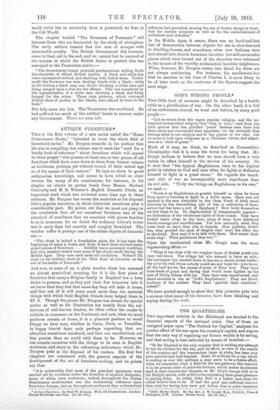ANTIQUE FURNITURE,*
Tars is the first volume of a new series called the " Home Connoisseur Series," "intended to cover the whole field of household curios." Mr. Burgess remarks in his preface that his aim in compiling this volume was to meet the "need for a handy book of reference" about furniture which will appeal to those people " who possess at least one or two pieces of old furniture which have come down to them from former owners as heirlooms, perhaps, yet without record of their actual age
or of the names of their makers." He lays no claim to great antiquarian knowledge, and seems to have relied on other writers for many of his conclusions; for instance, in his chapter on 'clocks he quotes freely from Messrs. Herbert Cescinsky and M. R. Webster's English Domestic Clocks, an
important work which was reviewed some time ago in these columns. Mr. Burgess has woven the materials at his disposal into a popular narrative, in which historical anecdotes play a considerable part. He points out that we must not jump to the conclusion that all our ancestors' furniture was of the standard of excellence that we associate with pieces familiar to us in museums, for no doubt the ordinary citizen's house was in early days but scantily and roughly furnished. The wooden coffer is perhaps one of the oldest objects of domestic use :— "The chest is indeed a foundation piece, for it has been the beginning of many a home, and from it have been evolved many grand pieces of furniture. . . . Solidity was a necessary condition, and very massive indeed were some of the chests made during the Middle Ages. They were used under all conditions. Richard III. slept on his military chest at the ' Blue Boar' at Leicester on the eve of the battle of Bosworth."
And now, to some of us, a plain wooden chest has assumed an almost symbolical meaning, for it is the first piece of furniture that many a Belgian family in England has a keen desire to possess, and as they put their few treasures into it we know that they feel that some day they will take it home, and that out of it will come much more than the material things with which their English friends have helped them to fill it. Though the pieces Mr. Burgess has chosen for special
notice as well as for illustration are mostly from the col- lections of well-known dealers, he often refers the reader to
exhibits in museums on the Continent, and now, when we must perforce remain at home, it is a pleasant pastime to recall things we have seen, whether in Cairo, Paris, or Versailles, in happy tourist days, only perhaps regretting that our attention sometimes wandered, and that our recollections are less precise than we could wish them to be. However, we can console ourselves with the things to be seen in English museums, and share in the refreshing enthusiasm which Mr.
Burgess puts at the disposal of his readers. His first few chapters are concerned with the general aspects of the development of the art of furniture-making, and he points out that
"It is noteworthy that most of the grandest specimens were carried out by workmen under the direction of superior designers, many of whom were architects ; indeed, throughout the Italian Renaissance architecture was the dominating influence upon furniture designs, just as throughout mediaeval days ecclesiastical • A tables Furniture, By Fred W. Burgess. With 126 Illustrations. London : George Routledge and Sons. [7s. 6d. net.]
influence had prevailed, causing the use of Gothic design in furni- ture for secular purposes as well as for the embellishment of cathedrals and churches."
In the Middle Ages, it seems, there was no hard-and-fast lino of demarcation between objects for use in churches and in dwelling-houses, and sometimes when new fashions were introduced into church furniture the older but still serviceable pieces which were turned out of the churches were welcomed in the houses of the wealthy ecclesiastics' humbler neighbours. When, however, Mr. Burgess enters into detail his dates are not always convincing. For instance, the needlework-box that he ascribes to the time of Charles I. is more likely to be of later work, as the costumes of the figures suggest the next reign.


































 Previous page
Previous page